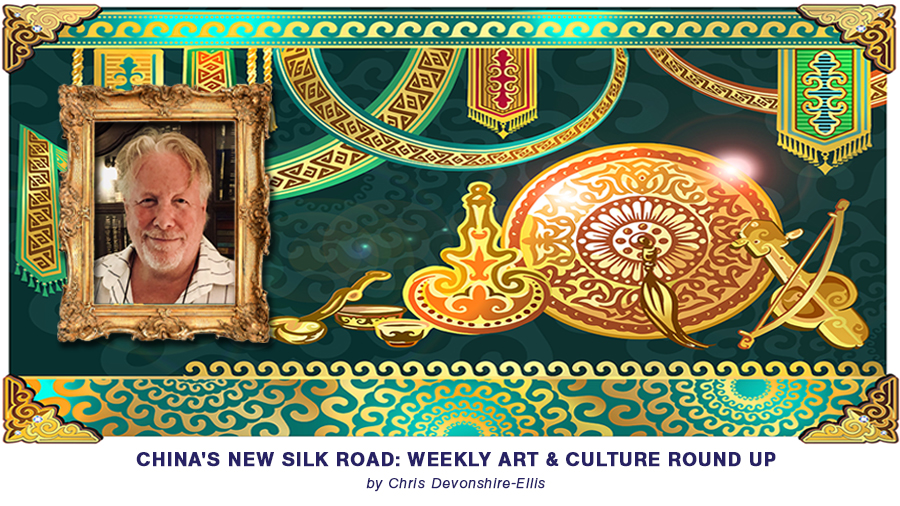China’s New Silk Road: Weekly Arts & Culture Round Up – June 5, 2020

 Walking To Samarkand
Walking To Samarkand
Walking to Samarkand is journalist Bernard Ollivier’s stunning account of the second leg of his 7,200-mile walk from Istanbul, Turkey, to Xi’an, China, along the Silk Road–the longest and perhaps most mythical trade route of all time. Picking up where his previous book Out of Istanbul left off, Ollivier heads out of the Middle East and into Central Asia, grappling not only with his own will to continue but with new, unforeseen dangers. After crossing the final mountain passes of Turkish Kurdistan, Ollivier sets foot in Iran, keen on locating vestiges of the silk trade as he passes through Persia’s modern cities and traditional villages, including Tabriz, Tehran, Nishapur, and the holy city of Mashhad. Beyond urban areas lie deserts: first Iran’s Great Salt Desert, then Turkmenistan’s forbidding Karakum, whose relentless sun, snakes, and scorpions pose continuous challenges to Ollivier’s goal of reaching Uzbekistan. Setting his own fears aside, he travels on, wonderstruck at every turn, borne by a childhood dream: to see for himself the golden domes and turquoise skies of Samarkand, one of Central Asia’s most ancient cities. But what Ollivier enjoys most are the people along the way: Askar, the hospitable gardener; the pilgrims of Mashhad; and his knights in shining armor, Mehdi and Monir. For, despite setting out alone, he comes to find that walking itself—through a kind of alchemy—surrounds him with friends and fosters fellowship. From the authoritarian mullahs of revolutionary Iran to the warm welcome of everyday Iranians—custodians of age-old, cordial Persian culture; from the stark realities of former Soviet republics to the region’s legendary bazaars—veritable feasts for the senses—readers discover, through the eyes of a veteran journalist, the rich history and contemporary culture of these amazing lands. The book can be obtained from Amazon here
 Curry – A Story Of Cooks and Conquerers
Curry – A Story Of Cooks and Conquerers
Curry tells the story of an array of familiar Indian dishes and the people who invented, discovered, cooked and ate them. Curry is vivid, entertaining and delicious, and tells the history of India and its rulers through their food. It follows the story of curry as it spread from the courts of Delhi to the balti houses of Birmingham. Curry is the product of India’s long history of invasion. In the wake of the Mughal conquerors, an army of cooks brought Persian recipes to northern India; in the south, Portugese spice merchants introduced vinegar marinades and the chillies they had recently discovered in the New World; the British soon followed, with their passion for roast meat accompanied by cauliflowers and beans. When these new ingredients were mixed with native spices, they produced these distinctly Indian dishes. With recipes included, this book will have you engaging with your kitchen and recreating the flavours of Persia and India. Available from Amazon here
 The Hu – Mongolian Rock
The Hu – Mongolian Rock
The Hu are a Mongolian supergroup combining rock with traditional instruments. They’ve just come off the back of a wildly successful US tour and have just released their first album “The Gereg”. Essential head-banging listening when bouncing around the Steppes in an old Russian jeep. Their video to the song “Yuve Yuve Yu” is below
 Raise The Red Lantern
Raise The Red Lantern
This film beautifully captures the essence of pre-war northern China, and is set near Xi’an, the beginning or the end of the old Silk Road depending on your perspective. It raised the Chinese actress Gong Li to international stardom as she plays the new wife of a wealthy merchant, only to fall victim to the scheming of his other concubines. Zhang Yimou’s sumptuously directed epic is based on the book “Wives & Concubines” by Su Tong, and won an Oscar for best foreign film of 1992. The condensed soul of China is contained within this work. It can be viewed on You Tube
 Chris’s Colonial Cocktails – The Gin Pahit
Chris’s Colonial Cocktails – The Gin Pahit
Any reader of the works by Somerset Maugham will be familiar with the Gin Pahit, his sleazy and sly Colonial characters were often imbibing them as their miserable lives stuttered into death and disease. The Gin Pahit has its origins in British Malaya, where it translates as “Bitter Gin”. It’s easy to make, and wards off malaria – probably. The recipe, according to the food and beverage service of the Raffles Hotel in Singapore, is 1½ ounces of gin and ½ ounce of Angostura bitters. At least one book on drinks from the 1930s describes it as identical to a pink gin, which would imply considerably less bitters. David A. Embury, in his book “The Fine Art of Mixing Drinks” states that a Gin Pahit is made with yellow gin and 3 dashes of Angostura bitters to 2 dashes of Absinthe. It’ll knock you on your ass, but wow what a way to get there…
About Us
Silk Road Briefing is published by Dezan Shira & Associates. Chris Devonshire-Ellis is the practice Chairman. Please contact Chris at silkroad@dezshira.com or through his Linked In account, or visit the firm at www.dezshira.com





